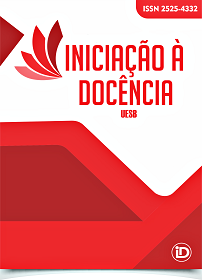Análise da conversa e critérios de textualidade: contribuições de estudos do discurso para pesquisas em sala de aula
DOI:
https://doi.org/10.22481/rid-uesb.v5i2.7157Keywords:
Teaching; Research; Classroom; Conversation Analysis; Textuality.Abstract
This paper has been motivated by discussions among the author and five doctoral students in sessions of a course titled Language Matters in Science Education, in a graduate program in Education for Science in São Paulo state, Brazil. During the study of conversation analysis and standards of textuality, it was found that the doctoral candidates were not familiar at all with the agenda. Later, after a search into the CAPES database, it was confirmed that publications on such topics in (science) education were scarce. Thus, a review has been provided of theoretical and methodological underpinnings of discourse studies that focus on conversation and textuality, especially how they help to plan and carry out classroom research aiming at critical reflection in teacher education. Excerpts are analyzed of data collected by the author in previous studies to illustrate how notions of conversation analysis and standards of textuality can be put to use. Thereby, it is intended that the dissemination of concepts and procedures in the fields of conversation analysis and standards of textuality can contribute to initial and continuing (science) teacher education as they inform interpretive research on classroom events.
Downloads
References
CONCÁRIO, M. A língua portuguesa e a construção do conhecimento escolar. 2009. 209f. Tese (Doutor) - IEL, UNICAMP, Campinas, 2009.
_____. Consciência Linguística o ensino de inglês como língua estrangeira: seu papel na abordagem comunicativa e na formação de professores. 2003. 218f. Dissertação (Mestrado) - IBILCE, Universidade Estadual Paulista, São José do Rio Preto, 2003.
_____. Encouraging students to language in the science classroom. Electronic Journal of Science Education, 20(3), p. 126-137, 2016.
COSTA VAL, M. G. Redação e textualidade. 4.ed. São Paulo/SP: Martins Fontes, 2016.
DALTON-PUFFER, C. The classroom as discourse space. In: _____. Discourse in content and language integrated learning (CLIL) classrooms. Amsterdam: John Benjamins, 2007, p. 15-44.
DE BEAUGRANDE, R. Text, discourse, and process. Toward a multidisciplinary science of texts. Volume IV in the series Advances in discourse processes. Norwood: Ablex, 1980.
DE BEAUGRANDE, R.; DRESSLER, W. Introduction to text linguistics. London: Longman, 1981.
FRONZA, C. A.; LORANDI, A.; LEMES, P. B. Dados de escrita em séries iniciais: ortografia, fonologia e textualidade. Trabalhos em Linguística Aplicada, v. 45, n. 2, p. 187-204, 2006.
GHAFARPOUR, H. Classroom conversation analysis and critical reflective practice: self-evaluation of teacher talk framework in focus. RELC Journal: a journal of language teaching and research, v. 48, n. 2, 2017, p. 210.
GREGOLIN, M. R. V. Linguística textual e ensino de língua: construindo a textualidade na escola. ALFA Revista de Linguística, v. 37, 2001.
LAND, C. L. Examples of critical coaching: an analysis of conversation between cooperating and teachers. Journal of Teacher Education, v. 69, n. 5, 2018, p. 493-507.
MAGGI, A. C.; RAMOS, I. J. Uma análise sobre a relação entre os critérios de textualidade e a elaboração de analogias no processo de ensino-aprendizagem. REVES Revista Relações Sociais, v. 1, n. 4, 2018, p. 661-72.
MATÊNCIO, M. L. M. Estudo da língua falada e a aula de língua materna: uma abordagem processual da interação professor/alunos. Campinas/SP: Mercado de Letras, 2001.
MOHAMADI ZENOUZAGH, Z. Multidimensional analysis of efficacy of multimedia learning in development and sustained development of textuality in EFL writing performances. Education and Information Technologies, v. 23, n. 6, 2018, p. 2969.
MORTON, T. Vocabulary explanations in CLIL classrooms: a conversation analysis perspective. Language Learning Journal, v. 43, n. 3, 2015, p. 256.
REEVES, S.; GREIFFENHAGEN, C.; LAURIER, E. Video gaming as practical accomplishment. Ethnomethodology, conversation analysis, and play. Topics in Cognitive Science, v. 9, n. 2, 2017, p. 308-43.
REYNOLDS, T. Striving for discussion: an analysis of a teacher educator’s comments in whole class conversation. Studying Teacher Education, v. 12, n. 2, 2016, p. 205.
ROCHA, M. S.; SILVA, M. M. P. A linguística textual e a construção do texto: um estudo sobre os fatores de textualidade. A cor das Letras, v. 18, n. 2, 2018.
SINCLAIR, J.; COULTHARD, M. Toward an analysis of discourse: the English used by teachers and pupils. Oxford: OUP, 1975.
_____. Towards an analysis of discourse. In: COULTHARD, M. (Ed.) Advances in spoken discourse analysis. London: Routledge, 1992, p. 1-34.
TANNER, M. Taking interaction in literacy events seriously: a conversation analysis approach to evolving literacy practices in the classroom. Language and Education, 31(5), p. 400, 2017.
TRAPPES-LOMAX, H. Discourse analysis. In: DAVIES, AL.; ELDER, C. (Ed.). The handbook of Applied Linguistics. Oxford: Blackwell, 2006, p. 133-64.







